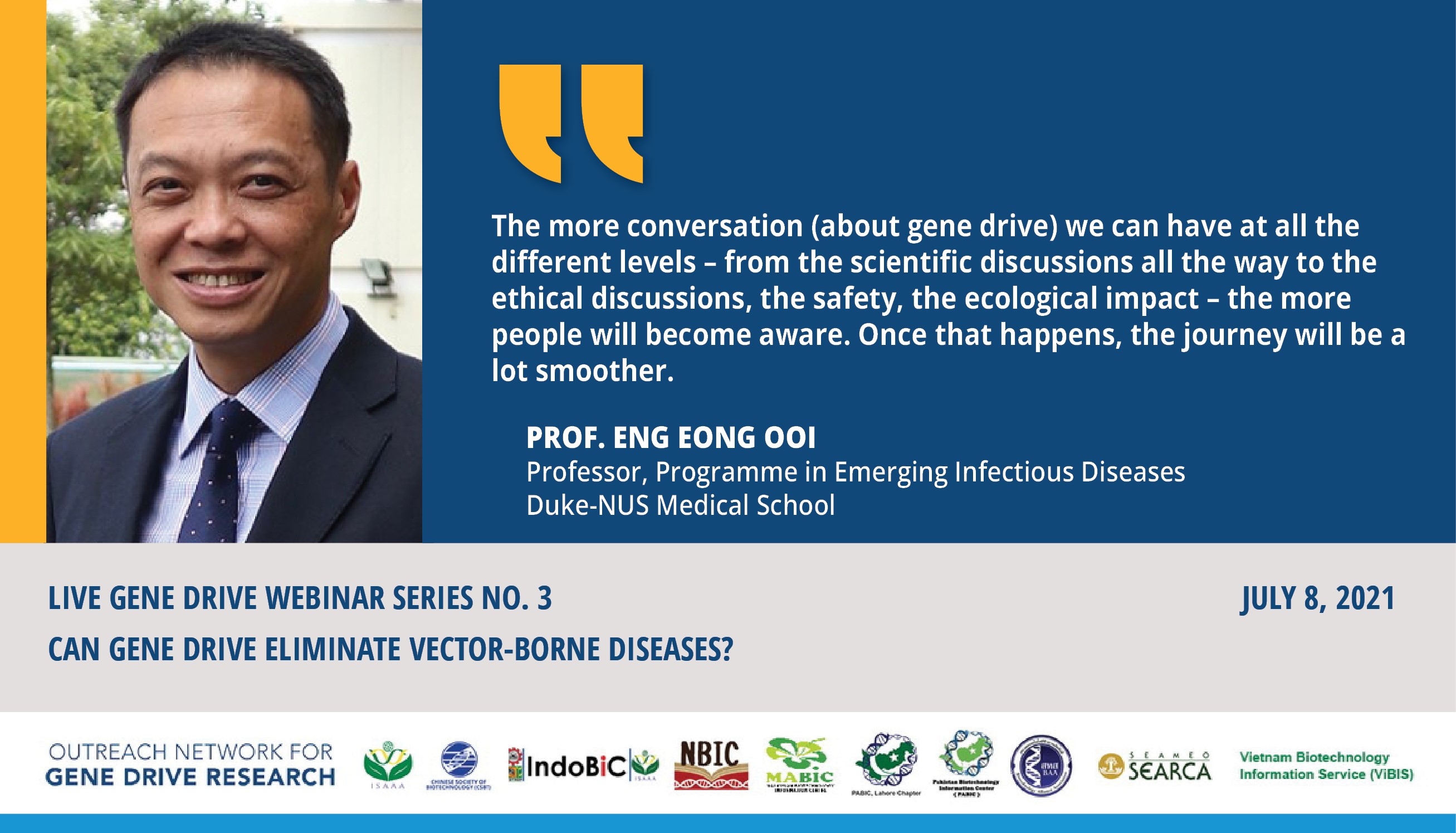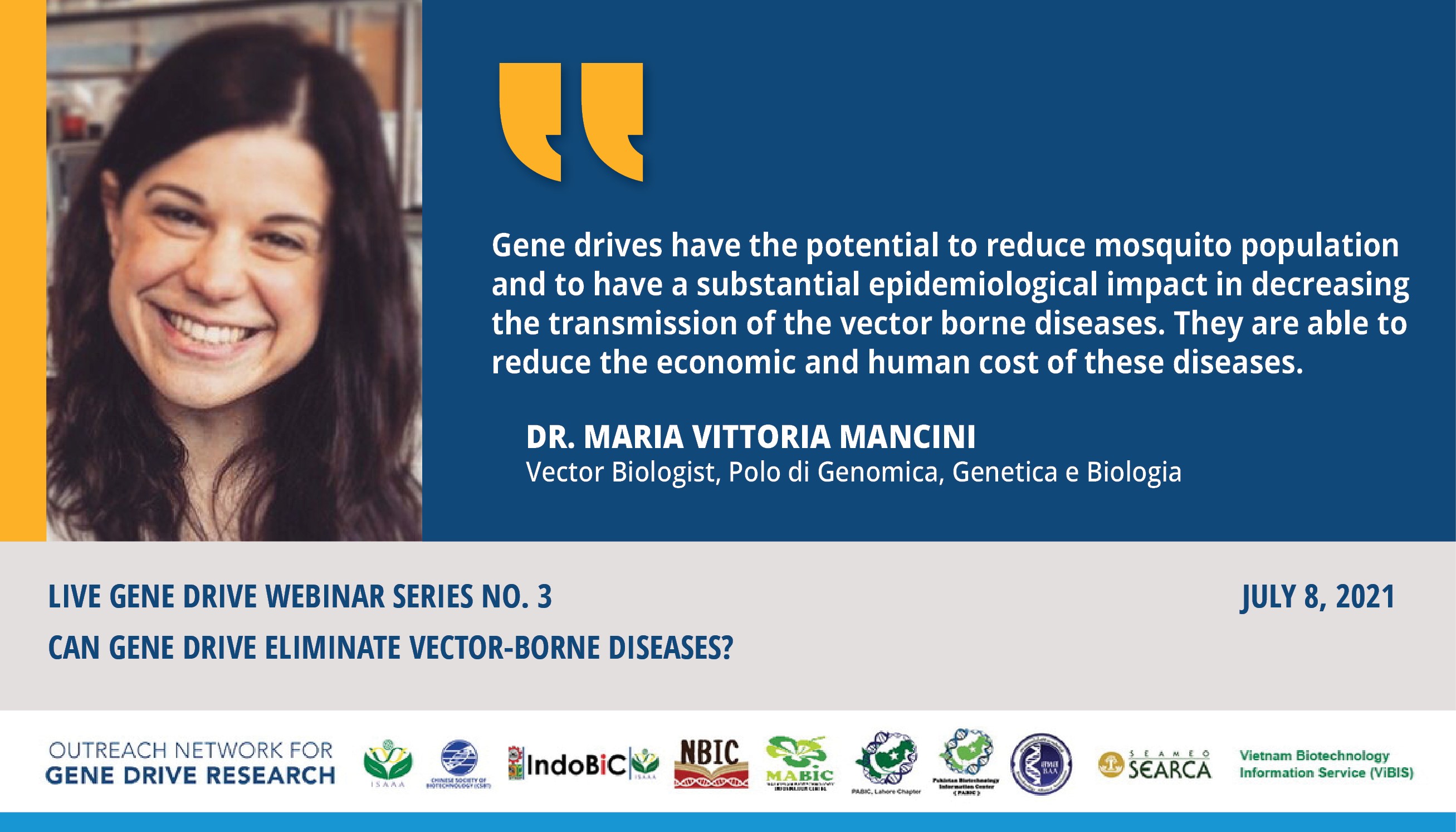Experts: Gene Drives Offer Sustainable Management fo Vector-Borne Diseases
| |

Dengue and Malaria are transmitted by mosquitoes and cause millions of deaths across the globe every year. Gene drives using genetically modified mosquitoes offer an effective, economical, and less labor-intensive solution to help fight lethal viral diseases.
The webinar Can gene drive eliminate vector-borne diseases? was live-streamed live via Zoom on July 8, 2021. It was hosted by ISAAA, in partnership with the Biotechnology Information Centers and the Outreach Network for Gene Drive Research. Experts from Singapore, Taiwan, and Italy were invited to speak about gene drive as a means to mitigate vector-borne diseases and their limitations.
Prof. Eng Eong Ooi of the Programme in Emerging Infectious Diseases of the Duke-NUS Medical School in Singapore provided an overview of the current Malaria and Dengue in Africa and Asia. He explained that millions of people become infected with both diseases every year, and some cases, especially in children, result in death. While pharmaceutical companies continue to develop anti-malarial and anti-dengue drugs to control the diseases, the efficacy of these medicines would either fade through time or even fail at trials prior to their approvals. "We still need an integrated control measure because not one single tool can prevent diseases like Dengue and Malaria. We need multiple approaches to try and tackle Malaria and Dengue," Prof. Eng said.

Gene drive is a tool that can help mitigate diseases. Malaria and Dengue are transmitted by mosquitoes, an insect that is a threat to public health according to Dr. Chun Hong Chen of the Institute of Infectious Disease and Vaccinology of the National Health Research Institutes in Taiwan. When an infected person is bitten by a mosquito, the mosquito becomes the virus' vector. Once it lands and bites other people, they also become infected. The cycle continues and the diseases spread, sometimes uncontrollably. Traditional methods such as clean-up drives and chemical fogging are currently being used to control the mosquito populations, but these are expensive and labor-intensive, said Dr. Chun. Gene drive is a more sustainable and cost-efficient solution. "There will be less need for repetitive releases once gene drive is developed. Compared with the original and traditional suppression method, it may be more economical. With its design, it will only affect specific species," Dr. Chun stated.
Dr. Maria Vittoria Mancini of the Polo di Genomica of the Genetica e Biologia in Italy supported the statements of her co-speakers. Aside from the advantages of gene drive, Dr. Mancini also explained the technology's limitations such as the reduced efficacy of the technology over time, public perception and ethical concerns, international regulations, and the ecological impacts. While there is an increasing need for additional innovation in vector control interventions, a transparent, inclusive, and well-informed discussion for responsible evaluations and development of genetic control technologies is also crucial. "The main aim of scientists, developers, and regulators is to develop the safest and most effective technology through responsible science and thorough risk assessments for every single step of development, testing, and potentially the application of the technology," Dr. Mancini said.

The webinar was opened by ISAAA Global Coordinator Dr. Mahaletchumy Arujanan and moderated by Dr. Sheetal Silal of the Modelling and Simulation Hub Africa at the University of Cape Town, South Africa. ISAAA SEAsiaCenter Director Dr. Rhodora Romero-Aldemita gave the closing remarks.
The Gene Drive Webinar Series will have the last session on July 22 and it will tackle the regulatory and governance considerations for gene drive research. To join the session on Regulatory and Governance Considerations for Gene Drive Research, register at http://bit.ly/GeneDriveWebinar4
Stay updated for ISAAA's upcoming webinars by subscribing to the Crop Biotech Update or following isaaa.org on Facebook, Twitter, and Instagram. The full video recordings of webinars 1, 2, and 3 are available on the ISAAA YouTube Channel.
| Newer Post | Archive | Older Post |
Science Speaks is ISAAA Inc.'s official blog. Weekly blog articles, authored by ISAAA writers, partners, and invited contributors, aim to help share, disseminate, and promote scientific knowledge and its vital role in achieving global agricultural sustainability and development. Your support to Science Speaks will help us achieve this goal. You can help us by donating as little as $10.

